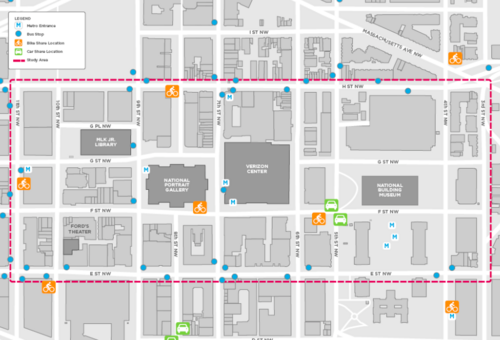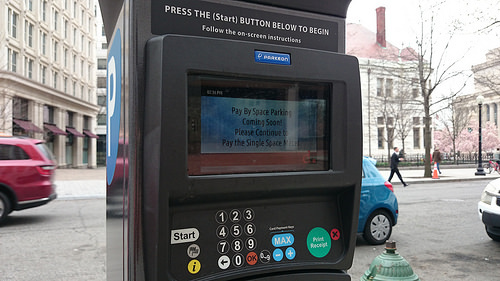DDOT’s newest performance parking program will be its best
In May, DDOT will launch its most robust performance parking experiment to date. The program, called ParkDC, will significantly change how people park in Gallery Place: the cost to park a car on some of downtown’s most in-demand blocks will rise or drop according to demand.
ParkDC’s boundaries will stretch from 11th to 3rd and from E to H Streets Northwest.
Under the performance parking program, DDOT will use cameras and sensors to measure when parking spaces in the designated area are occupied and when they’re empty.
Each quarter, the agency will measure that data against a target occupancy rate of 80-90% (or about one empty spot per block) and adjust how much it costs to park in a given spot accordingly. It’s possible that prices will change more frequently after the first few quarters, and DDOT will assess ParkDC’s overall impact sometime before the end of 2016.

A map of where ParkDC will go into effect. Image from DDOT.
Charging market rate for parking will make sure there are enough empty spots for people who need them while also eliminating an oversupply. That, in turn, will cut down on the congestion that comes from people driving around looking for somewhere to park.
ParkDC is based in part on the success of SFpark, which was introduced to several busy areas in central San Francisco in 2011. An evaluation of SFpark showed that the program made streets better for everyone, with 30% fewer miles driven, 23% fewer parking tickets, 22% less double parking, and 43% less time wasted looking for parking. The average price for parking even fell by 4%. Compared to control areas, buses ran faster and retail sales grew more.
The local business improvement district supports ParkDC: in its press release, businesses touted the project’s ability to make parking “easier to locate” and cut down on double parking and drivers circling for spaces.
ParkDC will be DDOT’s best parking effort to date
DDOT has tried pilots on Capitol Hill, H Street, and Columbia Heights. They were less successful than supporters hoped because DDOT did not have a cost-effective way to measure occupancy. It also didn’t put forth a schedule for updating the meter rates, nor a timeframe for evaluating effectiveness.
For each of these pilot areas, DDOT only reported occupancy data publicly twice, and it hasn’t changed prices in some places even when the data show they’re either too crowded or empty.
ParkDC’s real-time cameras and occupancy sensors, along with a pre-announced schedule, make the program smarter and more responsive.
According to Soumya Dey, DDOT’s director of research and technology transfer, ParkDC will use a number of methods to gather occupancy data. A traditional “hockey puck,” transaction data from the meters, historical data, cameras, and law enforcement data are all among the ways DDOT will know how many people park, and when, on each block. Dey said the hope is to use fewer embedded sensors, and to evaluate which method is most cost-effective.
Dey said that once the program is up and running, the public will be able to view spot occupancy in real time on DDOT’s website or its app.

